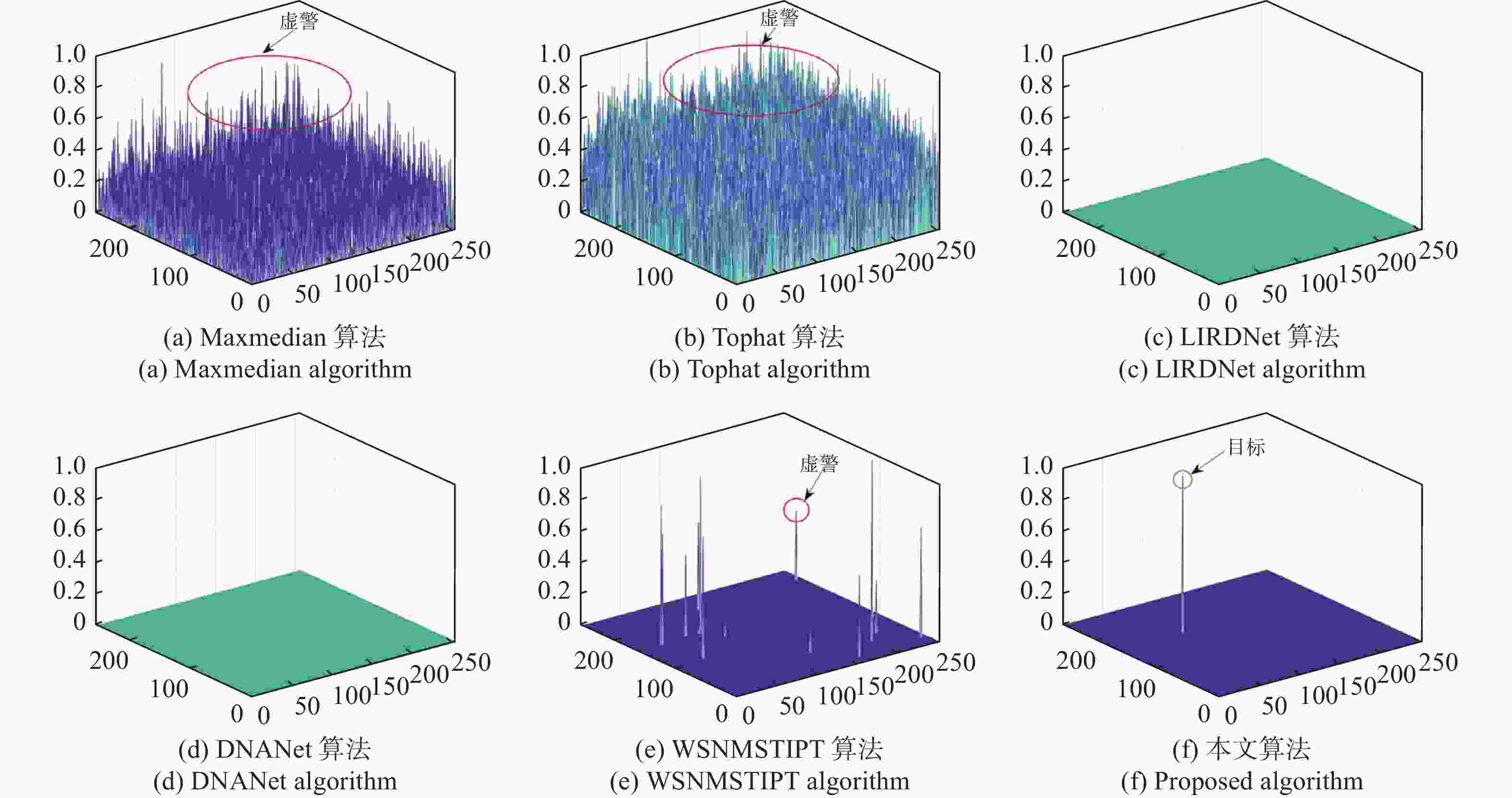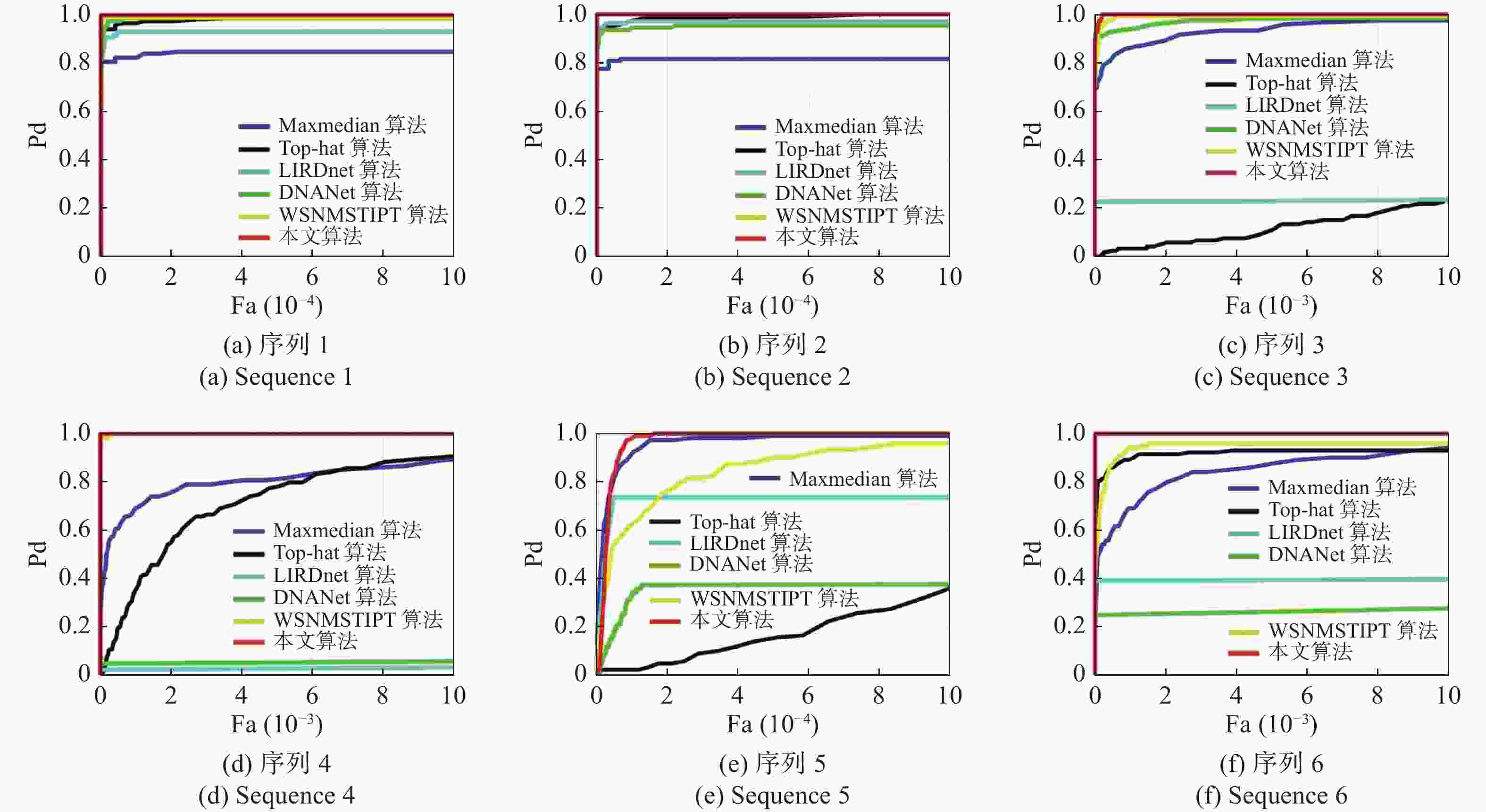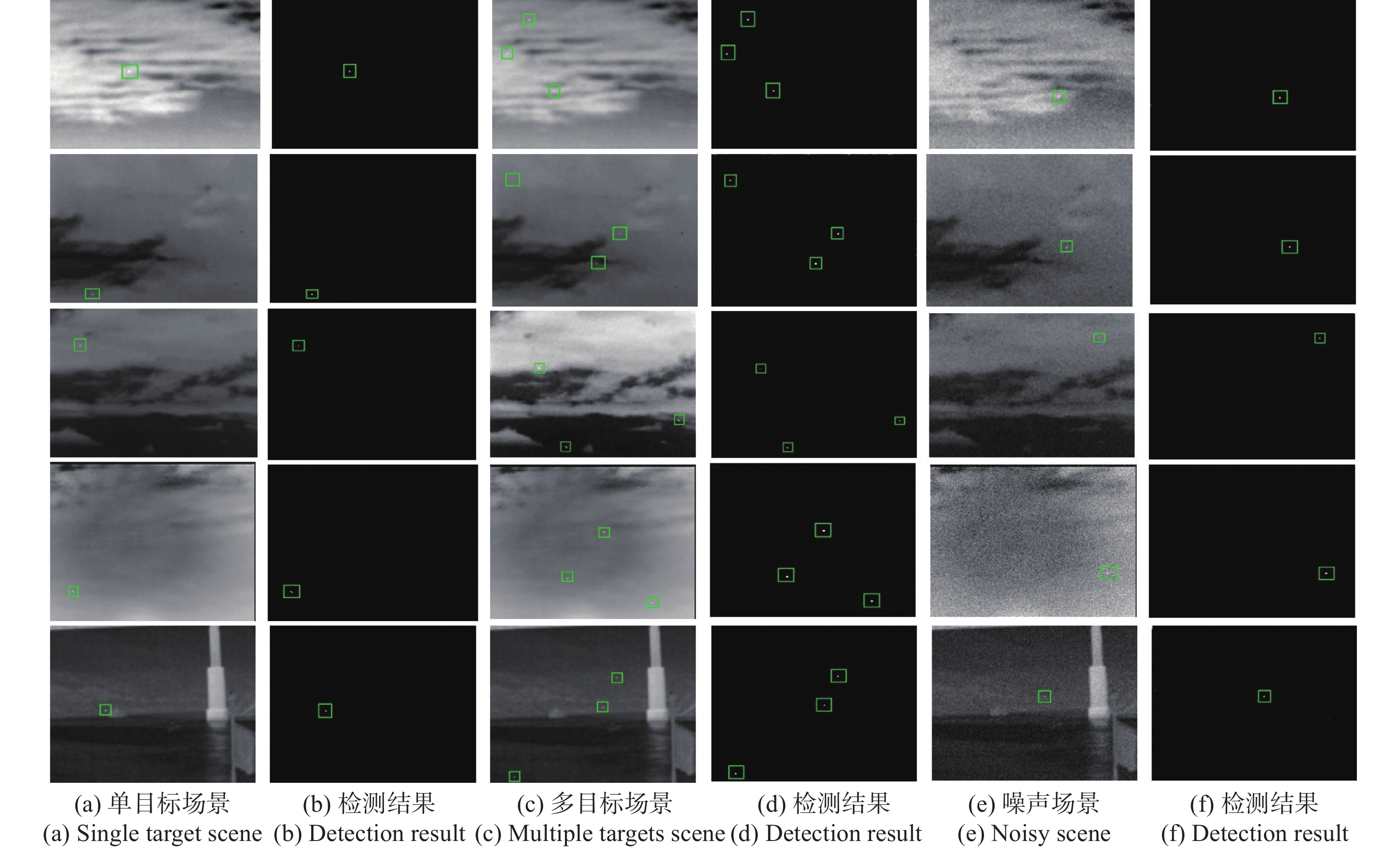Infrared small target detection via L1−2 spatial-temporal total variation regularization
-
摘要:
针对红外图像序列中复杂背景干扰下容易出现的高虚警问题,提出一种基于
${L_{1 - 2}}$ 时空域总变分正则项的红外弱小目标检测算法。首先,将红外图像序列转化为时空域红外张量块,该步骤可利用张量的高维数据结构优势关联图像序列中的时空域信息。然后,利用加权Schatten$p$ 范数和${L_{1 - 2}}$ 时空域总变分正则项对低秩背景成分进行重构,以保留背景中起伏剧烈的边缘和角点,提高稀疏目标的重构精度。最后,将目标张量恢复为图像序列,利用自适应阈值分割方法得到最终的目标图像。与另外5种检测算法进行对比实验,结果显示,该方法的虚警率较Maxemeidan算法、Tophat算法、LIRDNet算法、DNANet算法以及WSNMSTIPT算法平均分别下降了71.4%、71.1%、68.5%、74.3%和20.47%;而在检测实时性方面,该算法耗时为Maxemeidan算法、DNANet算法以及WSNMSTIPT算法的42.4%、82.9%和28.7%。实验结果验证了该方法在检测性能上的优越性,表明该算法能够显著提高复杂背景干扰下的目标检测精度和效率。Abstract:To solve the high false alarms caused by complex background clutters in infrared small-target detection, a novel detection method based on
${L_{1 - 2}}$ spatial-temporal total variation regularization is proposed. First, the input infrared image sequence is transformed into a Spatial-Temporal Infrared Patch-Tensor (STIPT) structure. This step can associate the spatial and temporal information by using the high dimensional data structures in the tensor domain. Then, weighted Schattenp -norm and${L_{1 - 2}}$ spatial-temporal total variation regularization are incorporated to recover the low-rank background component to preserve the strong edges and corners, which can improve the accuracy of sparse target component recovery. Finally, the STIPT structure can be transformed into an infrared image sequence by the inverse operator, and an adaptive threshold segmentation is used to obtain the real target. The method is verified using a contrast test with other five methods, and the experimental results show that the false alarm rate by this method decreases to 71.4%, 71.7%, 68.5%, 74.3% and 20.47% compared with the Maxemeidan, Tophat, LIRDNet, DNANet and WSNMSTIPT algorithms. The time cost also decreased to 42.4%, 82.9% and 28.7% of that of the Maxemeidan, DNANet and WSNMSTIPT. The extensive experimental results demonstrate the superiority of this method in detection performance, which can greatly improve the accuracy and efficiency of target detection with complex background clutters. -
表 1
$ {L_{1 - 2}} $ STTV模型的求解Table 1. The solution of
$ {L_{1 - 2}} $ STTV model输入:红外图像序列${f_1},{f_2}, \cdots ,{f_P} \in { {\mathcal{R} }^{m \times n} }$,帧数步长$L$,正则化参数${\lambda _1},{\lambda _2},\alpha .$
输出:背景张量${ { {\mathcal{B} } }^k}$,目标张量${ { {\mathcal{T} } }^k}$,噪声张量${ {\mathcal{N} }^k}.$
初始化:输入图像序列转化为原始张量${ {\mathcal{F} } },$$\rho = 1.1,$
${ {\mathcal{B} }^0} = { {\boldsymbol{ {\mathcal{T} } } }^0} = { {\mathcal{N} }^0} = 0,{\mathcal{Y} }_1^0 = {\mathcal{Y} }_2^0 = 0,$${ {\mathcal{W} }^0} = {\mathcal{I} }$,Schattern $p$范数指数$p = 0.8,$${\mu _0} = 1\times10^{-2},{\mu _{\max } } = 1\times10^7,k = 0.$迭代循环: 收敛误差条件不满足时,执行
1. 根据式(12)更新背景张量${ {\mathcal{B} }^{k + 1} }$;
2. 根据式(22)、(23)、(24)更新${ {\mathcal{Z} }^{k + 1} }$;
3. 根据式(27)更新目标张量${ {\mathcal{T} }^{k + 1} }$;
4. 根据式(29)更新噪声张量${ {\mathcal{N} }^{k + 1} }$;
5. 根据式(30)、(31)更新拉格朗日乘子和$ {\mu ^{k + 1}} $;
6. 根据式(32)更新背景权重张量${ {\mathcal{W} }^{k + 1} }$;
7. 判断下列收敛条件是否满足:
${ {\left\| { {\mathcal{F} } - {\mathcal{B} } - {\mathcal{T} } - {\mathcal{N} } } \right\|_F^2} \mathord{\left/ {\vphantom { {\left\| { {\mathcal{F} } - {\mathcal{B} } - {\mathcal{T} } - {\mathcal{N} } } \right\|_F^2} {\left\| {\mathcal{F} } \right\|_F^2} } } \right. } {\left\| {\mathcal{F} } \right\|_F^2} } \leqslant \varepsilon$
满足则跳出循环,输出结果,否则执行步骤8;
8. 迭代次数$k = k + 1$,返回步骤1;表 2 实验数据特性
Table 2. The characteristic of the experimental data
序号 帧数 尺寸 背景特性 目标SCR 1 120 250×200 天空场景,卷云层和噪声干扰 2.24 2 120 200×150 天空场景,云层和噪声干扰 4.35 3 120 128×128 地面场景,高亮背景干扰 2.13 4 120 200×158 天空场景,高亮云层干扰 0.94 5 120 256×256 地面场景,高亮杂波干扰 1.76 6 120 256×256 地面场景,高亮杂波干扰 1.01 表 3 不同方法在序列1至序列3的评价指标
Table 3. Quantitative evaluation results of the tested methods for the representative images of sequences 1-3
算法 序列1的第24帧 序列2的第92帧 序列3的第60帧 LSNRG BSF SCRG CG LSNRG BSF SCRG CG LSNRG BSF SCRG CG Maxmedian 0.53 0.73 1.97 2.72 1.88 2.52 6.58 2.61 0.82 0.71 3.19 4.48 Tophat 0.91 0.63 1.60 2.53 1.35 1.07 1.80 1.68 1.05 1.32 1.46 1.11 LIRDNet 1.04 2.43 16.89 4.93 1.29 8.27 31.85 3.85 0.94 1.70 4.68 2.75 DNANet 0.99 1.41 6.88 4.88 2.37 12.30 39.25 3.19 0.98 2.13 4.52 2.12 WSNMSTIPT 1.06 1.72 13.35 7.75 Inf Inf Inf 7.81 1.09 1.50 5.49 3.66 本文算法 1.12 2.98 22.82 7.67 Inf Inf Inf 8.87 1.10 2.51 14.43 5.75 表 4 不同方法在序列4至序列6的评价指标
Table 4. Quantitative evaluation results of the tested methods for the representative images of sequences 4-6
算法 序列4的第76帧 序列5的第72帧 序列6的第117帧 LSNRG BSF SCRG CG LSNRG BSF SCRG CG LSNRG BSF SCRG CG Maxmedian 2.35 2.05 12.94 6.30 1.39 1.29 11.58 8.95 0.88 2.62 12.59 4.80 Tophat 2.29 1.52 5.69 3.75 1.27 0.94 4.97 5.30 1.02 1.11 3.07 2.77 LIRDNet NaN Inf NaN 0.00 Inf Inf Inf 20.06 NaN Inf NaN 0.00 DNANet NaN Inf NaN 0.00 NaN Inf NaN 0.00 NaN Inf NaN 0.00 WSNMSTIPT Inf Inf Inf 7.27 2.50 5.02 73.53 14.65 1.93 14.64 100.25 6.85 本文算法 Inf Inf Inf 15.85 Inf Inf Inf 23.16 Inf Inf Inf 12.33 表 5 算法运行时间比较
Table 5. Runtime comparison of different algorithms
(s) 算法 序列1 序列2 序列3 序列4 序列5 序列6 Tophat 1.93 1.65 1.15 2.20 2.16 2.70 Maxmedian 174.39 110.18 58.47 114.21 205.67 209.48 LIRDNet 19.92 39.13 16.64 38.45 76.36 83.62 DNANet 31.26 65.41 33.42 58.24 130.19 126.58 WSNMSTIPT 79.87 80.41 66.20 74.34 527.15 459.19 本文算法 20.81 47.69 24.83 51.82 109.69 114.93 -
[1] 黄乐弘, 曹立华, 李宁, 等. 深度学习的空间红外弱小目标状态感知方法[J]. 中国光学,2020,13(3):527-536.HUANG L H, CAO L H, LI N, et al. A state perception method for infrared dim and small targets with deep learning[J]. Chinese Optics, 2020, 13(3): 527-536. (in Chinese) [2] QIU Z, MA Y, FAN F, et al. Adaptive scale patch-based contrast measure for dim and small infrared target detection[J]. IEEE Geoscience and Remote Sensing Letters, 2022, 19: 1-5. [3] WAN M J, GU G H, XU Y K, et al. Total variation-based interframe infrared patch-image model for small target detection[J]. IEEE Geoscience and Remote Sensing Letters, 2022, 19: 7003305. [4] 何耀民, 何华锋, 徐永壮, 等. 基于改进小波变换的海上目标检测[J]. 系统工程与电子技术,2020,42(1):83-89. doi: 10.3969/j.issn.1001-506X.2020.01.12HE Y M, HE H F, XU Y ZH, et al. Marine target detection based on improved wavelet transform[J]. Systems Engineering and Electronics, 2020, 42(1): 83-89. (in Chinese) doi: 10.3969/j.issn.1001-506X.2020.01.12 [5] DU J M, LU H ZH, ZHANG L P, et al. A spatial-temporal feature-based detection framework for infrared dim small target[J]. IEEE Transactions on Geoscience and Remote Sensing, 2022, 60: 3000412. [6] CHEN Y H, LI L Y, LIU X, et al. A multi-task framework for infrared small target detection and segmentation[J]. IEEE Transactions on Geoscience and Remote Sensing, 2022, 60: 5003109. [7] LIU X, LI L Y, LIU L Q, et al. Moving dim and small target detection in multiframe infrared sequence with low SCR based on temporal profile similarity[J]. IEEE Geoscience and Remote Sensing Letters, 2022, 19: 7507005. [8] WANG G H, TAO B J, KONG X, et al. Infrared small target detection using nonoverlapping patch spatial–temporal tensor factorization with capped nuclear norm regularization[J]. IEEE Transactions on Geoscience and Remote Sensing, 2022, 60: 5001417. [9] REED I S, GAGLIARDI R M, STOTTS L B. Optical moving target detection with 3-D matched filtering[J]. IEEE Transactions on Aerospace and Electronic Systems, 1988, 24(4): 327-336. doi: 10.1109/7.7174 [10] LI M, ZHANG T X, YANG W D, et al. Moving weak point target detection and estimation with three-dimensional double directional filter in IR cluttered background[J]. Optical Engineering, 2005, 44(10): 107007. doi: 10.1117/1.2056586 [11] BAI X ZH, ZHOU F G. Analysis of new top-hat transformation and the application for infrared dim small target detection[J]. Pattern Recognition, 2010, 43(6): 2145-2156. doi: 10.1016/j.patcog.2009.12.023 [12] DESHPANDE S D, ER M H, VENKATESWARLU R, et al. Max-mean and max-median filters for detection of small targets[J]. Proceedings of SPIE, 1999, 3809: 74-83. doi: 10.1117/12.364049 [13] LIU Y, PENG ZH M. Infrared small target detection based on resampling-guided image model[J]. IEEE Geoscience and Remote Sensing Letters, 2022, 19: 7002405. [14] CHEN C L P, LI H, WEI Y T, et al. A local contrast method for small infrared target detection[J]. IEEE Transactions on Geoscience and Remote Sensing, 2014, 52(1): 574-581. doi: 10.1109/TGRS.2013.2242477 [15] WEI Y T, YOU X G, LI H. Multiscale patch-based contrast measure for small infrared target detection[J]. Pattern Recognition, 2016, 58: 216-226. doi: 10.1016/j.patcog.2016.04.002 [16] DENG H, SUN X P, LIU M L, et al. Small infrared target detection based on weighted local difference measure[J]. IEEE Transactions on Geoscience and Remote Sensing, 2016, 54(7): 4204-4214. doi: 10.1109/TGRS.2016.2538295 [17] MCINTOSH B, VENKATARAMANAN S, MAHALANOBIS A. Infrared target detection in cluttered environments by maximization of a target to clutter ratio (TCR) metric using a convolutional neural network[J]. IEEE Transactions on Aerospace and Electronic Systems, 2021, 57(1): 485-496. [18] 林再平, 李博扬, 李淼, 等. 结合跨尺度特征融合与瓶颈注意力模块的轻量型红外小目标检测网络[J]. 红外与毫米波学报,2022,41(6):1102-1112. doi: 10.11972/j.issn.1001-9014.2022.06.020LIN Z P, LI B Y, LI M, et al. Light-weight infrared small target detection combining cross-scale feature fusion with bottleneck attention module[J]. Journal of Infrared and Millimeter Waves, 2022, 41(6): 1102-1112. (in Chinese) doi: 10.11972/j.issn.1001-9014.2022.06.020 [19] LI B Y, XIAO C, WANG L G, et al. Dense nested attention network for infrared small target detection[J]. IEEE Transactions on Image Processing, 2022, 32: 1745-1758. [20] GAO CH Q, MENG D Y, YANG Y, et al. Infrared patch-image model for small target detection in a single image[J]. IEEE Transactions on Image Processing, 2013, 22(12): 4996-5009. doi: 10.1109/TIP.2013.2281420 [21] WANG Q Q, GAO Q X, SUN G, et al. Double robust principal component analysis[J]. Neurocomputing, 2020, 391: 119-128. doi: 10.1016/j.neucom.2020.01.097 [22] DAI Y M, WU Y Q. Reweighted infrared patch-tensor model with both nonlocal and local priors for single-frame small target detection[J]. IEEE Journal of Selected Topics in Applied Earth Observations and Remote Sensing, 2017, 10(8): 3752-3767. doi: 10.1109/JSTARS.2017.2700023 [23] SUN Y, YANG J G, LI M, et al. Infrared small target detection via spatial–temporal infrared patch-tensor model and weighted Schatten p-norm minimization[J]. Infrared Physics &Technology, 2019, 102: 103050. [24] SUN Y, YANG J G, LI M, et al. Infrared small-faint target detection using non-i. i. d. mixture of Gaussians and flux density[J]. Remote Sensing, 2019, 11(23): 2831. doi: 10.3390/rs11232831 [25] SUN Y, YANG J G, AN W. Infrared dim and small target detection via multiple subspace learning and spatial-temporal patch-tensor model[J]. IEEE Transactions on Geoscience and Remote Sensing, 2021, 59(5): 3737-3752. doi: 10.1109/TGRS.2020.3022069 [26] BOYD S, PARIKH N, CHU E, et al. Distributed optimization and statistical learning via the alternating direction method of multipliers[J]. Foundations and Trends ® in Machine Learning, 2011, 3(1): 1-122. [27] LOU Y F, YIN P H, HE Q, et al. Computing sparse representation in a highly coherent dictionary based on difference of L1 and L2[J]. Journal of Scientific Computing, 2015, 64(1): 178-196. doi: 10.1007/s10915-014-9930-1 [28] TAO P D, AN L T H. A D. C. optimization algorithm for solving the trust-region subproblem[J]. SIAM Journal on Optimization, 2017, 8(2): 476-505. [29] LOU Y F, ZENG T Y, OSHER S, et al. A weighted difference of anisotropic and isotropic total variation model for image processing[J]. SIAM Journal on Imaging Sciences, 2015, 8(3): 1798-1823. doi: 10.1137/14098435X [30] BECK A, TEBOULLE M. A fast iterative shrinkage-thresholding algorithm for linear inverse problems[J]. SIAM Journal on Imaging Sciences, 2009, 2(1): 183-202. doi: 10.1137/080716542 [31] 赵鹏鹏, 李庶中, 李迅, 等. 融合视觉显著性和局部熵的红外弱小目标检测[J]. 中国光学,2022,15(2):267-275.ZHAO P P, LI SH ZH, LI X, et al. Infrared dim small target detection based on visual saliency and local entropy[J]. Chinese Optics, 2022, 15(2): 267-275. (in Chinese) [32] 程博阳, 李婷, 王喻林. 基于视觉显著性加权与梯度奇异值最大的红外与可见光图像融合[J]. 中国光学,2022,15(4):675-688.CHENG B Y, LI T, WANG Y L. Fusion of infrared and visible light images based on visual saliency weighting and maximum gradient singular value[J]. Chinese Optics, 2022, 15(4): 675-688. (in Chinese) [33] 刘杨帆, 曹立华, 李宁, 等. 基于YOLOv4的空间红外弱目标检测[J]. 液晶与显示,2021,36(4):615-623. doi: 10.37188/CJLCD.2020-0227LIU Y F, CAO L H, LI N, et al. Detection of space infrared weak target based on YOLOv4[J]. Chinese Journal of Liquid Crystals and Displays, 2021, 36(4): 615-623. (in Chinese) doi: 10.37188/CJLCD.2020-0227 -









 下载:
下载:









